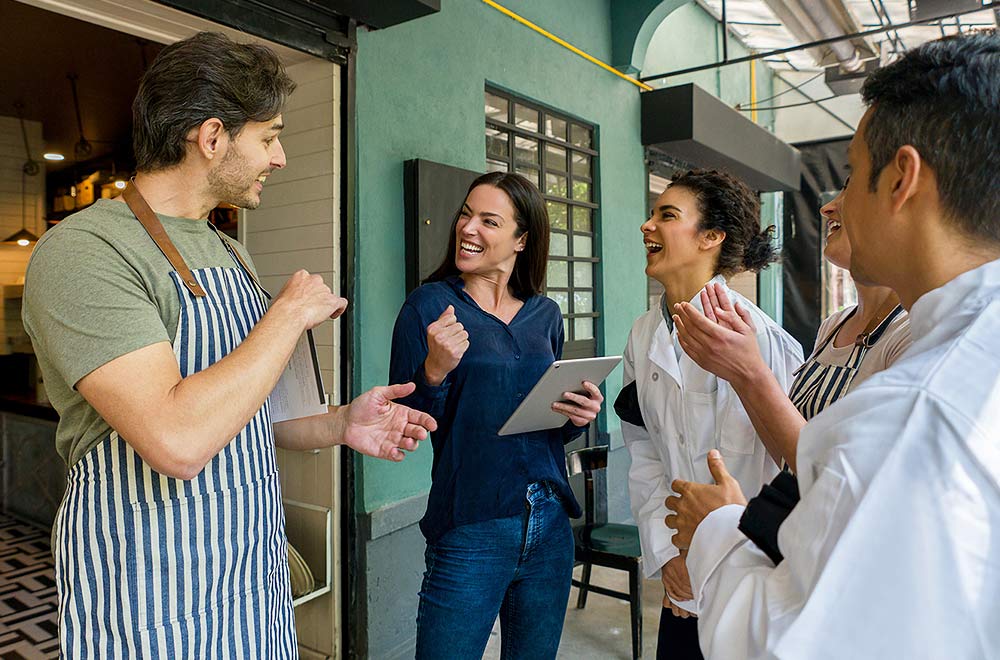Teamwork is the cornerstone of many businesses and is an especially important component of a successful restaurant. By ensuring that all team members are working toward a common goal, both staff and customers will have a more optimal experience. Effective teamwork involves careful planning and ongoing team training that focuses on using each person’s individual strengths to further the restaurant’s business goals. By investing in teamwork initiatives, your restaurant can benefit from increased staff morale, lower turnover rates, and employees that genuinely are motivated to do well at their job.
When all departments—kitchen staff, hosts, servers, and management—aren’t aligned on a common outcome, there can be severe disconnects that can negatively impact your business and customer experience. Poor communication is often the root cause of a team that’s not functioning cohesively. This can manifest as employees arguing, the staff having a general lack of consideration for their coworkers, and the front-of-house and back-of-house teams not communicating.
Fortunately, we’ve assembled some tips that can improve teamwork in a restaurant while helping employees work together to produce successful results.
1. Hire wisely
Ultimately, your hiring process should predict how well a candidate will work long term with your staff and customers. Key qualities to look for in a potential hire include:
- Motivated
- Committed
- Team player
- Confident
- Good people skills
- Organized
- Enthusiastic
- Reliable
- Leader
Someone who possesses these characteristics and aligns with your restaurant’s culture is more likely to stick around for the long haul. Involving team members in the hiring process that the new employee will be working alongside is a smart way to determine whether a potential hire will seamlessly integrate into your current staff structure. For instance, a manager may be looking for very different criteria than the new recruit’s team members. If a person checks all the boxes in terms of skills and culture, but there are potential personality clashes, this will do more harm than good.
Employee retention is crucial to a well-functioning and sustainable restaurant. Less employee turnover leads to a stable work environment, which in turn boosts the spirit of your entire team. Plus, investing in staff longevity cuts down on the time and resources you’ll need to allocate to training new hires.
2. Establish effective communication
Creating effective lines of communication across all departments and team members is vital to the success of a restaurant. Like with any business, when employees are happy and working well together, they’re more likely to provide better service to customers. Establishing and modeling communication expectations starts at the top with the management team and flows down to the other employees. Managers should be adept listeners and encourage their staff to always share honest feedback.
Communication can be improved by clarifying roles, setting expectations, specifying goals, and having clear processes in place. For example, it’s important to have your daily procedures written down and conveyed during regularly scheduled staff meetings. Such tasks may include prepping food in the morning, cleaning kitchen/bar stations throughout the day, and rolling silverware at night. When all employees are communicating effectively, your restaurant’s productivity, employee satisfaction, and staff retention can all thrive.

3. Clarify roles
Ambiguity regarding roles and responsibilities can lead to unbalanced amounts of work and resentment between employees. To combat this, it’s important for roles and responsibilities to be clearly documented. This documentation should be available in an employee handbook or posted in the back-of-house, so people can refer to it.
To define roles, look at the different positions within your restaurant, including management, and decipher the job description, tasks, and responsibilities for each. It’s equally important for your staff to understand their own personal role as well as the roles of their coworkers. By crystallizing each role’s expected contribution to the restaurant, the entire staff can work together more efficiently. This can reduce conflict and ignite productivity.
4. Outline expectations
It’s the management team’s duty to outline staff expectations to ensure everyone understands what they need to accomplish each shift. This can include:
- Dress code—define what attire the front-of-house and back-of-house staff should wear during shifts
- Cleanliness—kitchen, bussers, servers, and cleaning crew should properly clean their stations each day
- Guest relations—train your staff on how to appropriately treat customers to ensure they have an ideal dining experience
- Reliability—team members should arrive on time for their shift, so they don’t inconvenience their coworkers
- Attitude—maintaining a positive and team-oriented attitude is paramount since unforeseen circumstances can arise during a restaurant shift
5. Don’t micromanage
Micromanagement is a management style where a manager closely observes or controls the work of employees. This approach typically has a negative connotation because it can imply that the manager distrusts the employee to manage their time and complete their assigned responsibilities. Major pitfalls of micromanagement can include a loss of trust between managers and team members as well as high turnover rates when unhappy employees inevitably resign. This overbearing style of management can also lead employees to be dependent on “handholding” from management rather than tapping into their own confidence and drive. It’s often said, “innovation is the key to progress.” Micromanaging does not cultivate an environment where employees feel empowered to contribute unique ideas and perspectives. Your restaurant could be missing out on revenue-generating initiatives.
If you hire employees that are a good fit and train them properly, there should be a mutual trust that tasks and responsibilities will be effectively completed. Be sure to encourage innovation from your staff, show each employee that you genuinely care about their wellbeing, and listen to all feedback you receive from team members.

6. Encourage feedback
Oftentimes, great ideas can come from unexpected places. To achieve your restaurant’s long-term goals, it’s wise to request ideas and feedback from all roles within the restaurant. Brainstorming sessions can be an efficient tool for generating ideas. This will also get team members that may not work together much to share insights and experiences that could fuel positive changes in the restaurant.
It’s also valuable to open as many feedback channels as possible. Some employees will deliver excellent insights during one-on-one meetings with their managers, whereas others may prefer to voice their opinions using an anonymous feedback box. It’s management’s job to take employee feedback seriously and make appropriate changes. This in turn can create a workplace culture where everyone feels valued, allowing the entire team and your business to flourish.
7. Reward excellent teamwork
One of the best ways to build camaraderie in a restaurant workplace is to give formal recognition for employee achievements such as excellent teamwork. If an individual goes above and beyond their role to help your business, ensure that they feel appreciated for their efforts. Also, remember to acknowledge employees who go out of their way to help other team members in need, even if this doesn’t correlate with their daily responsibilities. Showing gratitude for altruistic behavior is a surefire way to create a positive and friendly culture. Recognition can come in the form of kind words from a direct manager, or perhaps a reward like a gift card or a weekend off with a description of the achievement.
When you have a workplace where people are rewarded for helping one another, teamwork and business goals can naturally improve. In fact, organizations with formal employee recognition programs have 31% less voluntary turnover than organizations that don’t have any programs at all. And they’re 12 times more likely to have strong business outcomes. This illustrates how connected recognizing employee achievements is to your restaurant’s overall success and longevity.

8. Encourage social events
Social connections in the workplace can dramatically impact an employee’s mood, performance, and stress levels. Fostering positive workplace connections can have numerous positive outcomes for your staff such as reducing stress and increasing engagement, loyalty, and happiness—prompting an overall healthier life for your team. Curating planned social events and outings can give employees who don’t typically work together a chance to meet and bond.
Ideas that can spur socialization between departments and all team members include:
- Celebrations for birthdays, holidays, general employee appreciation, etc.
- Team building exercises
- Volunteering for a local nonprofit organization
- Team wellness challenges
- Hosting a potluck or team breakfast
- Creating a social spot in the back-of-house area
- Outings to local shows, events, and other restaurants
Be sure to regularly visit our free resource section dedicated to navigating the constantly changing foodservice industry. There, you’ll find blog articles, free downloads, and restaurant guides.






